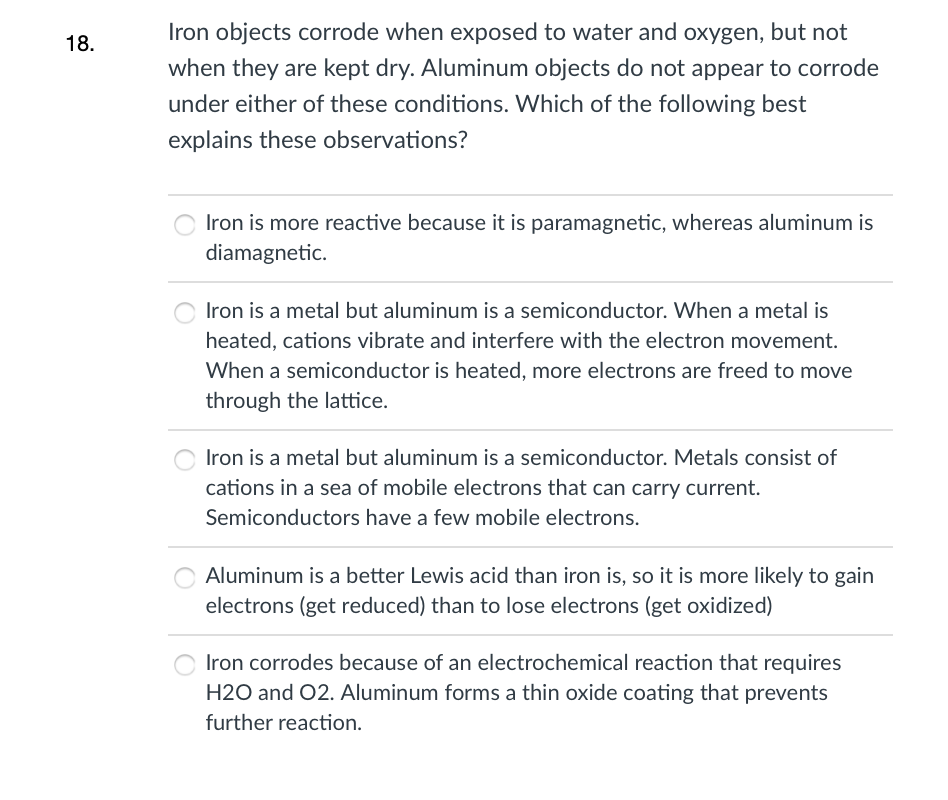Iron objects corrode when exposed to water and oxygen, but not when they are kept dry. Aluminum objects do not appear to corrode under either of these conditions. Which of the following best explains these observations? Iron is more reactive because it is paramagnetic, whereas aluminum is diamagnetic. Iron is a metal but aluminum is a semiconductor. When a metal is heated, cations vibrate and interfere with the electron movement. When a semiconductor is heated, more electrons are freed to move through the lattice. Iron is a metal but aluminum is a semiconductor. Metals consist of cations in a sea of mobile electrons that can carry current. Semiconductors have a few mobile electrons. Aluminum is a better Lewis acid than iron is, so it is more likely to gain electrons (get reduced) than to lose electrons (get oxidized) Iron corrodes because of an electrochemical reaction that requires H2O and 02. Aluminum forms a thin oxide coating that prevents further reaction.
Iron objects corrode when exposed to water and oxygen, but not when they are kept dry. Aluminum objects do not appear to corrode under either of these conditions. Which of the following best explains these observations? Iron is more reactive because it is paramagnetic, whereas aluminum is diamagnetic. Iron is a metal but aluminum is a semiconductor. When a metal is heated, cations vibrate and interfere with the electron movement. When a semiconductor is heated, more electrons are freed to move through the lattice. Iron is a metal but aluminum is a semiconductor. Metals consist of cations in a sea of mobile electrons that can carry current. Semiconductors have a few mobile electrons. Aluminum is a better Lewis acid than iron is, so it is more likely to gain electrons (get reduced) than to lose electrons (get oxidized) Iron corrodes because of an electrochemical reaction that requires H2O and 02. Aluminum forms a thin oxide coating that prevents further reaction.
Chemistry by OpenStax (2015-05-04)
1st Edition
ISBN:9781938168390
Author:Klaus Theopold, Richard H Langley, Paul Flowers, William R. Robinson, Mark Blaser
Publisher:Klaus Theopold, Richard H Langley, Paul Flowers, William R. Robinson, Mark Blaser
Chapter17: Electrochemistry
Section: Chapter Questions
Problem 22E: The mass of three different metal electrodes, each from a different galvanic cell, were determined...
Related questions
Question
100%

Transcribed Image Text:Iron objects corrode when exposed to water and oxygen, but not
18.
when they are kept dry. Aluminum objects do not appear to corrode
under either of these conditions. Which of the following best
explains these observations?
Iron is more reactive because it is paramagnetic, whereas aluminum is
diamagnetic.
Iron is a metal but aluminum is a semiconductor. When a metal is
heated, cations vibrate and interfere with the electron movement.
When a semiconductor is heated, more electrons are freed to move
through the lattice.
Iron is a metal but aluminum is a semiconductor. Metals consist of
cations in a sea of mobile electrons that can carry current.
Semiconductors have a few mobile electrons.
Aluminum is a better Lewis acid than iron is, so it is more likely to gain
electrons (get reduced) than to lose electrons (get oxidized)
Iron corrodes because of an electrochemical reaction that requires
H2O and 02. Aluminum forms a thin oxide coating that prevents
further reaction.
Expert Solution
This question has been solved!
Explore an expertly crafted, step-by-step solution for a thorough understanding of key concepts.
Step by step
Solved in 2 steps

Knowledge Booster
Learn more about
Need a deep-dive on the concept behind this application? Look no further. Learn more about this topic, chemistry and related others by exploring similar questions and additional content below.Recommended textbooks for you

Chemistry by OpenStax (2015-05-04)
Chemistry
ISBN:
9781938168390
Author:
Klaus Theopold, Richard H Langley, Paul Flowers, William R. Robinson, Mark Blaser
Publisher:
OpenStax

Principles of Modern Chemistry
Chemistry
ISBN:
9781305079113
Author:
David W. Oxtoby, H. Pat Gillis, Laurie J. Butler
Publisher:
Cengage Learning

General Chemistry - Standalone book (MindTap Cour…
Chemistry
ISBN:
9781305580343
Author:
Steven D. Gammon, Ebbing, Darrell Ebbing, Steven D., Darrell; Gammon, Darrell Ebbing; Steven D. Gammon, Darrell D.; Gammon, Ebbing; Steven D. Gammon; Darrell
Publisher:
Cengage Learning

Chemistry by OpenStax (2015-05-04)
Chemistry
ISBN:
9781938168390
Author:
Klaus Theopold, Richard H Langley, Paul Flowers, William R. Robinson, Mark Blaser
Publisher:
OpenStax

Principles of Modern Chemistry
Chemistry
ISBN:
9781305079113
Author:
David W. Oxtoby, H. Pat Gillis, Laurie J. Butler
Publisher:
Cengage Learning

General Chemistry - Standalone book (MindTap Cour…
Chemistry
ISBN:
9781305580343
Author:
Steven D. Gammon, Ebbing, Darrell Ebbing, Steven D., Darrell; Gammon, Darrell Ebbing; Steven D. Gammon, Darrell D.; Gammon, Ebbing; Steven D. Gammon; Darrell
Publisher:
Cengage Learning

Chemistry: The Molecular Science
Chemistry
ISBN:
9781285199047
Author:
John W. Moore, Conrad L. Stanitski
Publisher:
Cengage Learning

Chemistry: Principles and Practice
Chemistry
ISBN:
9780534420123
Author:
Daniel L. Reger, Scott R. Goode, David W. Ball, Edward Mercer
Publisher:
Cengage Learning

Chemistry: An Atoms First Approach
Chemistry
ISBN:
9781305079243
Author:
Steven S. Zumdahl, Susan A. Zumdahl
Publisher:
Cengage Learning